Torrance Art Museum SUR:biennial 2013
SUR:Biennial > 2013 > Torrance
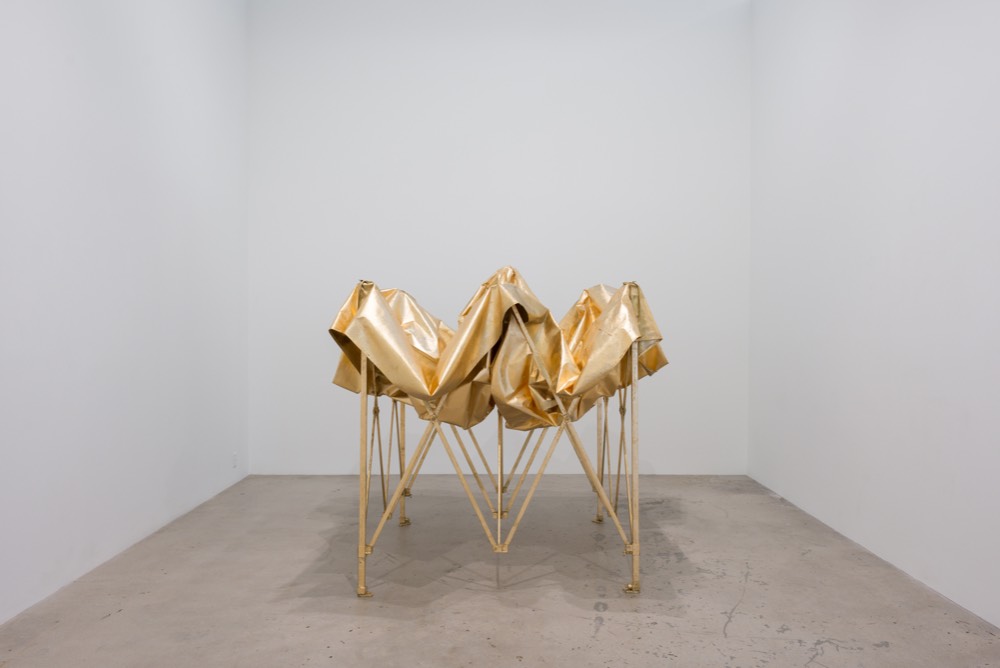
Carmen Argote, Gold-Leaf Canopy (Selig Zoo), 60" x 78" x 60", 2012. Courtesy of the
Artist.
Carmen Argote
Born in Guadalajara, Mexico, Carmen Argote is a Los Angeles-based artist who has lived in and around the downtown area most of her life. She received both her BFA and MFA from UCLA, with a specialization in ceramics under the mentorship of Adrian Saxe. In 2009, she was an artist-in-residence at the Skowhegan School of Painting and Sculpture. In 2010, she created a dual-site-specific exhibition that took place at her childhood home in Pico Union and at Gallery G727, later recreated at the Vincent Price Art Museum. Argote is a 2013 recipient of the California Community Foundation emerging artist fellowship grant and, also this year, she received a MTA commission to create the artwork for the future Metro Expo Line station at 17th and Colorado in Santa Monica. The station is set to open in early 2016.
Statement
An exploration on the influence of site and place has been a central theme in my work. I have often looked at the shape of spaces as a source of inspiration to investigate memory, movement, systems, and manipulation by design. My artwork stems from the personal but attempts to transcend into a larger conversation that explores the culture of the landscape that is Los Angeles. In my work, I use historical fragments, stories, personal experience and imagination to create a layered picture of the past, the present, and the imagined stories in-between. From apartment layouts to amusement parks, my interest in the construction of memory as it relates to site incorporates the idea of the footprint, the mental imprint, the ghost story, and the lingering presence or haunting of a place. The lingering of sites and spaces that were once there, but are now gone, has become of great interest to me as I explore the ways in which the past manifests itself presently and layers itself upon the identity of a place. Imagination and play together with explorations of haunting, histories, muscle memory, and story telling have inspired me to create objects that function as layered gestures of these ideas. Los Angeles in many ways acts as my northern light, I use the fantasies, the nostalgia, the myths, and the trends as cultural inventory for my practice. I work on a human scale, where architecture, and objects become my materials for art making. I move through disparate materials and bodies of work in search of what I call the poetic; a gesture between materials that attempts to reveal a truth; that creates a layering between cultural and contextual references, landing in sculptural form. Working through fragments of historical photos and narratives about a movie studio and theme park, called Selig’s Zoo, that once stood adjacent to the hills across from my Lincoln Heights studio in the 1910s, I felt compelled to return to the hills to explore the absence of development and the stillness of the landscape. The Ascot hills, as they are now known, are the only hills without any development on them in the area, and, as such, they represent for me the natural landscape of Los Angeles and hold an optimistic spirit that I associate with inspiring farfetched ideas and big dreams.
The theme of coming to Los Angeles to fulfill one’s fantasy and the breath of optimism and pessimism inherent in the search for the dream reveals itself in the Gold-Leafed Canopy. Half collapsed, the canopy exists with the potential to open fully with its entrepreneurial spirit or to collapse entirely. In The Tiger Barrel, a draped tiger striped fashion jumpsuit lays over the cylindrical form. The layering of past fragments with the present continues in this work. The Tiger Barrel can read like a white fence wrapped into a cylinder, a display-like form, or as an attempt to replicate the original. The jumpsuit is put on display like a new dress, but the work also has the suggestion that it has been discarded as soon as in was bought.
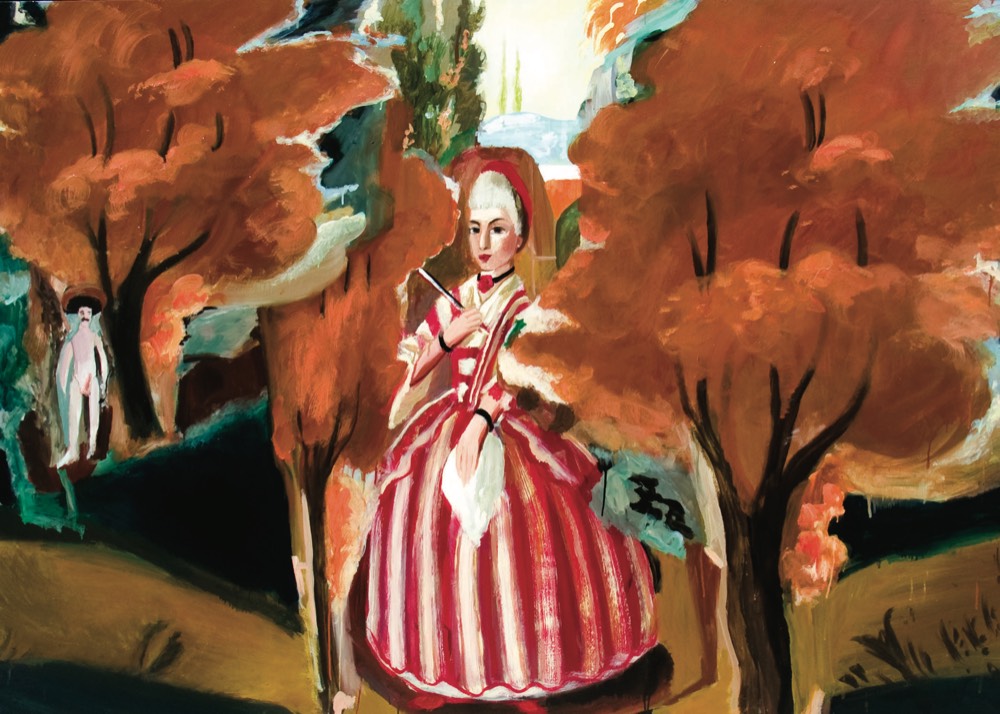
Alida Cervantes, Criolla considerando las consecuencias de cojerse a un charro Indino,
Oil on wood, 60" x 80", 2011
Alida Cervantes
Born in San Diego, and currently living/working between San Diego and Tijuana, Alida Cervantes earned a BA and a MFA from the University of California, San Diego, and studied at Scuola di Arte Lorenzo di Medici in Florence, Italy. Her solo exhibition, Los Más Bárbaros, was presented at Steve Turner Contemporary. She has also been included in numerous group exhibitions, including Chewbacca to Zapata: Revisiting the Myth of the Mexican Revolution at Morono Kiang Gallery, Homing In at Mark Quint Gallery, Viva Mexico at the Zacheta National Gallery in Warsaw, Poland, New Contemporaries at Simay Space, and Strange New World: Art and Design from Tijuana at the Museum of Contemporary Art San Diego.
Statement
My paintings are inspired by colonial Mexican casta paintings, which depict a variety of racially diverse couples and their offspring in different settings, often arranged denoting their social class. My own variation on this tradition depicts mixed-raced men, women and children using a loosely painted style to create an eerie, disjointed interpretation of race amidst images of violence and aggression.
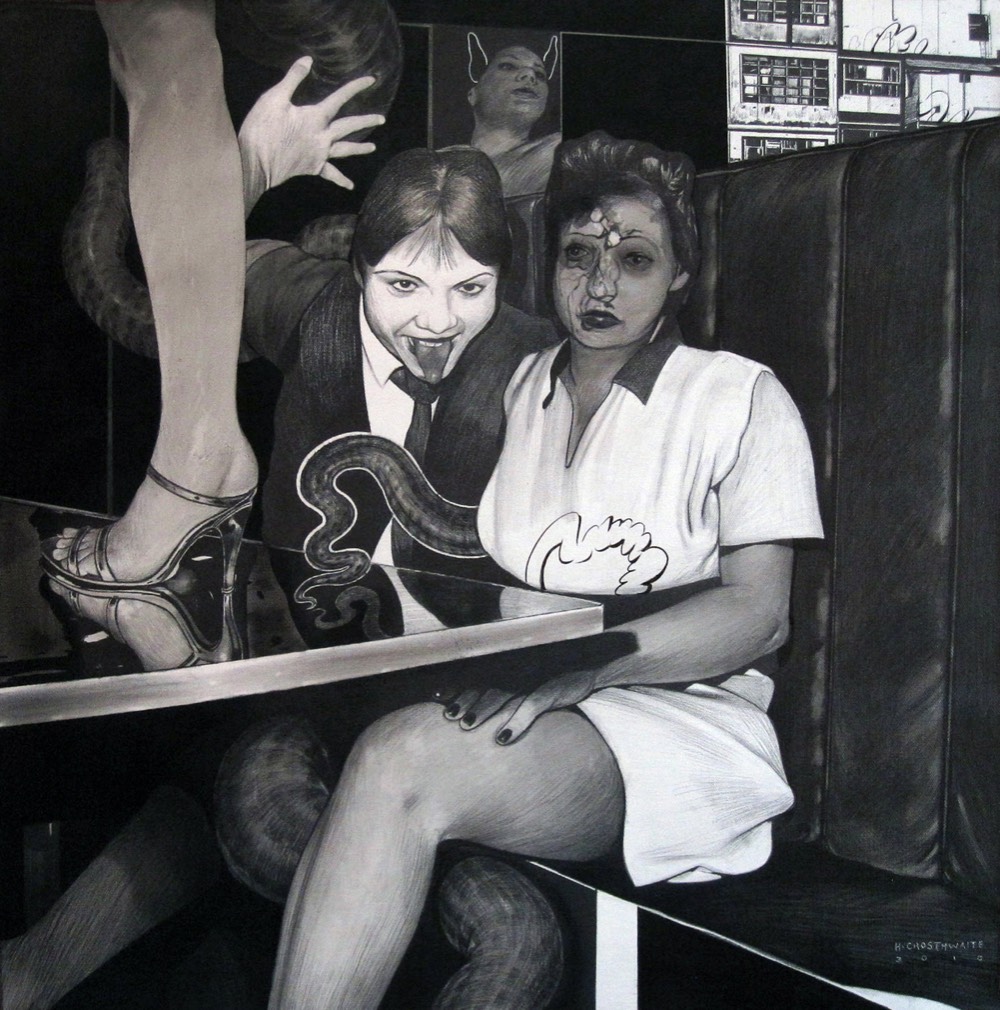
Hugo Crosthewaite, Cafe Drama Lacoon, Graphite & Charcoal on Canvas, 24" x 24", 2010.
Hugo Crosthwaite
Hugo Crosthwaite was born in Tijuana and spent his formative years in Rosarito, Mexico. He graduated from San Diego State University in 1997 with a BA in Applied Arts. Crosthwaite lives and works between his studios in San Diego and Mexico. His works are in the permanent collections of LACMA; Miami Art Museum, FL; Boca Raton Museum of Art, FL; Museum of Contemporary Art San Diego, CA; Museum of Latin American Art, Long Beach, CA; and San Diego Museum of Art, CA. Recent exhibitions include Salon für Kunstbuch, Vienna, Austria; California Pacific Triennial 2013, Orange County Museum of Art, Newport Beach, CA; Studies for Carpas, Luis De Jesus Los Angeles; The New World, Wignall Museum of Contemporary Art, Chaffey College, Rancho Cucamonga, CA; The Very Large Array, works from the permanent collection, Museum of Contemporary Art San Diego; Behold, America!, San Diego Museum of Art; Carnivorall, Pierogi, Brooklyn, NY; Tjuanerias, Luis De Jesus Los Angeles; Morbid Curiosity: The Richard Harris Collection, Chicago Cultural Center; and Brutal Beauty: Drawings by Hugo Crosthwaite, San Diego Museum of Art; TRANSactions: Contemporary Latin American and Latino Art, Museum of Contemporary Art San Diego; El Grito/The Cry for Freedom, Univ. of Arkansas, Little Rock, AK; Strange New World: Art & Design from Tijuana, Santa Monica Museum of Art, CA; VII Bienal Monterrey 2005, Mexico; XII Bienal Rufino Tamayo 2005, Museo Tamayo Arte Contemporáneo, Mexico City; and The Perception of Appearances: A Decade of American Contemporary Figurative Drawing, Frye Art Museum, Seattle, WA.
Statement
Allowing the act of drawing to organically dictate my compositions, I juxtapose a wide range of textures and tones against spaces that alternate from dense and atmospheric to flat and graphic. Francisco Goya, Eugene Delacroix, Gustave Doré, Jose Guadalupe Posada, and Arnold Böcklin are among the many artists that have inspired my work. The joining of abstraction with classically-rendered imagery creates a feeling of spontaneity and vagueness; each work becomes an enfoldment of personal vision in which reality, history, and mythology collide as I explore the complexities of human expression. My series, Tijuanerias, pays homage to Goya's Caprichos, with its depiction of grotesque and surrealistic figures and themes executed in an informal, sketch-like style. The figures - everyday men, women and children that populate my native city of Tijuana - are presented in a non-idealized documentary style that allows them to appear in their humble familiarity and authenticity. Like Goya, I alternate between mythological subjects and contemporary ones, often combining the two.
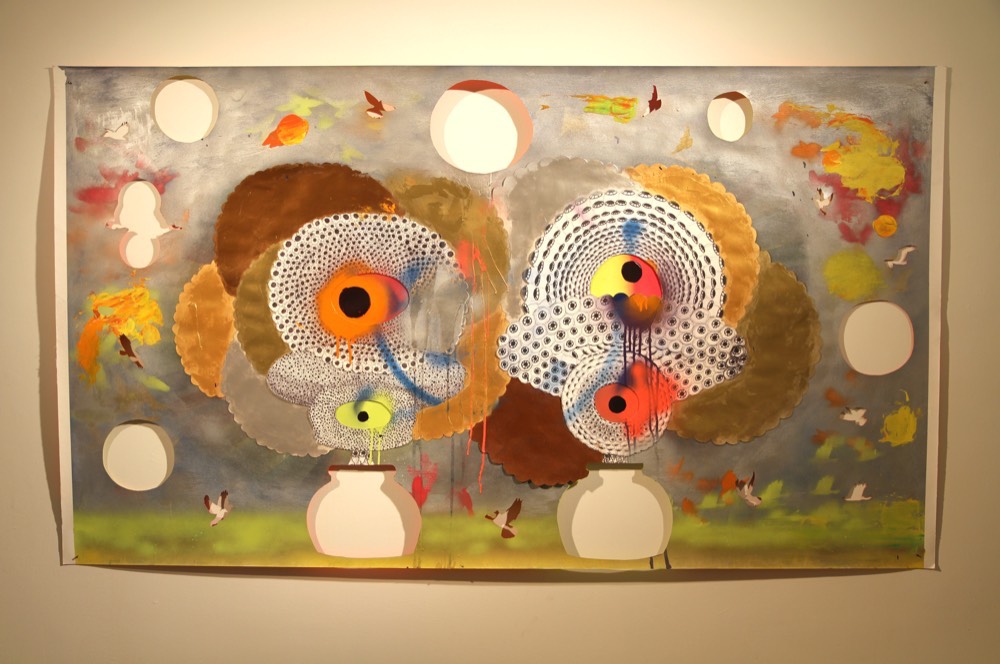
Walpa D'mark, Fission Fusion Confusion, Acrylic on Paper, 48" x 72", 2013.
Walpa D’Mark
Walpa D'Mark is a Nicaraguan-American artist, born in Managua and living/working in Los Angeles. He received his BFA from California State University Long Beach and his MFA from Claremont Graduate University. D’Mark has exhibited locally at Coagula Curatorial, POST Gallery, Gallery 314, Greenleaf Gallery at Whittier College, Mark Moore Gallery, Raid Projects, and High Energy Constructs; nationally at House Gallery in Salt Lake City; and Internationally in South Korea, Mexico, and Germany.
Statement
I paint with oil on canvas. My colors are saturated and bright, some have called them psychedelic, others think that they are very Latino, and others refer to my pallet as Fauvist. I agree. My paint application is smooth at times, and thick and visceral at others. Formally, I am interested in creating compositions involving the “interior room” with symbolic elements filling the space. The symbolic elements create open-ended narratives for the viewers, but also create a personal narrative for me. My personal narrative is idiosyncratic and complex, but if there is a star, it is Wilt. He is a character that egotistically plays god. Within the confines of his studio, he creates art that strives to be pure and optimistic, but at best, ends up reflecting his fears and insecurities, and at worst, mocks God, faith and hope. He does so with a strong belief in Humanism, and an even stronger disbelief in humans, and an unbelievable amount of self-doubt.
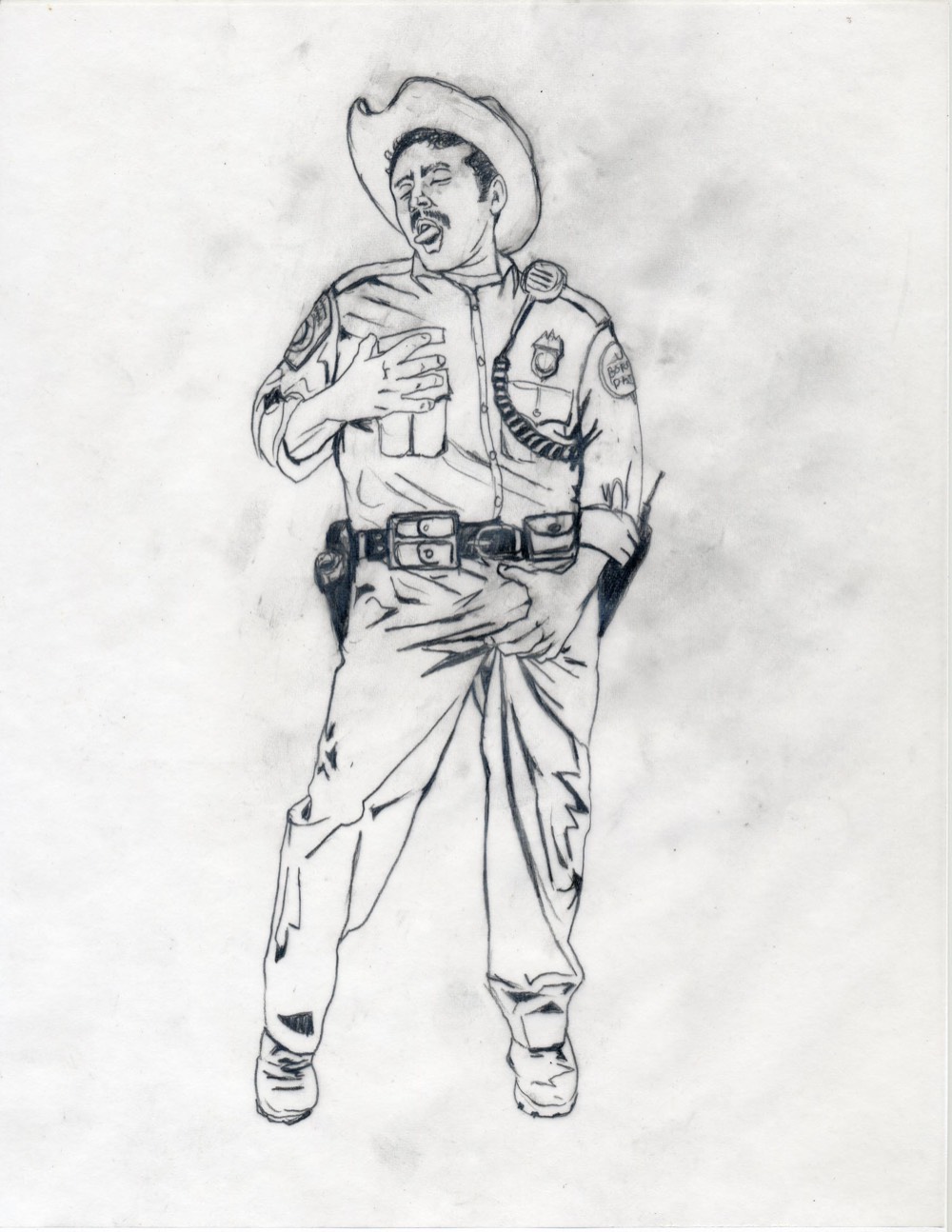
Alex Donis, Wet Dreams (Suenos Mojados), Acrylic on Fabric, One of Four Panels, 48"
x 84" each, 2007.
Alex Donis
Born in Chicago and living/working in Los Angeles, Alex Donis received his undergraduate degree at California State University, Long Beach and his graduate degree from Otis College of Art & Design. Interested in examining and redefining the boundaries set within religion, politics, race, and sexuality, and by extension toppling societies’ conventional attitudes, his work is often influenced by a tri-cultural (Pop, Latino, and Queer) experience. Working extensively in a variety of media including painting, installation, video, and works on paper, his work has been at the heart of several controversial incidents that have stirred national debates regarding censorship in the arts. He has participated in hundreds of national and international individual and group exhibitions, most notably: “Made in California: Art, Image & Identity 1900-2000” at the LA County Museum of Art and The 10th Biennale of Havana, Cuba. He has exhibited his work at the Hammer Museum, the Santa Monica Museum of Art, the Geffen Contemporary at MOCA Los Angeles, the Laguna Museum of Art, Los Angeles Contemporary Exhibitions (LACE), the Mexican Museum in San Francisco, Randolph Street Gallery in Chicago, Galeria de la Raza in San Francisco, Pretoria Arts Museum in South Africa, and Artspace in Sydney Australia. His work has appeared in numerous publications including Art in America, Flash Art, Artpapers, ArtForum, ArtNews , the New York Times, and most recently Art and Queer Culture published by Phaidon Press. Donis has been awarded residencies at the Brandywine Institute, Philadelphia; Artspace, Sydney, Australia and the 18th Street Arts Center, Santa Monica. He was the guest curator for Collaboration Labs: Southern California Artists and the Artist Space Movement, which was part of the 2011 Getty initiative Pacific Standard Time: Art in LA 1945-1980. His work is in the permanent collection of LACMA, the San Diego Museum of Art, and the Blanton Museum of Art, at the University of Texas, Austin.
Statement
To police a border is to monitor a landscape for the expression of physical desire. Territories, such as the US/Mexico border and homosexuality, have a shifting and unresolved relationship within our social structure. I see the queer landscape as a place for the expression, however naïve, towards liberated space. Sueños Mojados (Wet Dreams) bears witness to the ‘intimate immensity’ of the border and condenses a fiery daydream of infinite erotic possibilities. Originally created for Arte Nuevo Interactiva in Merida, Mexico, and then shown at the 10th Bienal of Habana, Cuba, this project manifests as an installation of suspended banners constructed from translucent silk fabric. Painted onto these panels are a series of US Border Patrol Officers in crotch-grabbing and nipple-tugging ecstasy all creating an erotic parameter unearthing layers beneath machismo that expose a Bacchanalian spirit of erotic foreplay, a transnational circle jerk - made in Los Angeles, but kept warm in Mexico.
Still from Zoe Gruni's Boitata, Digital Video, 13 minutes, 2013.
Zoe Gruni
Born in Pistoia, Italy, and currently living between Florence, Los Angeles and Rio de Janeiro, Zoè Gruni obtained her diplome at Istituto d’arte of Pistoia, with a secondary degree from the Accademia di Belle Arti of Florence, through the Andrea Granchi’s School of Painting where she was awarded the Studenti Eccellenti Prize and exhibited her work at the Accademia delle Arti del Disegno. By opening the Contemporary Art Space Studi8 in Pistoia, in partnership with other artists, she maintained a close connection to her home town, where her work was bought by the Fondazione Cassa di Risparmio of Pistoia & Pescia and presented at Palazzo Fabroni inside the exhibition 1910 - 2010: un secolo d’arte a Pistoia (1910 – 2010: a century of art in Pistoia). Her sculptures have also served as the dramaturgic element of Conversazione con la pietra (Conversation with the stone), a show created in partnership with the actor/musician Piero Corso and the actress Tania Garribba for the Festival Via Cava, Roselle. After coming to the US, as an artist-in-residence at Raid Projects in LA and an artist-member of the Orange County Center for Contemporary Art in Santa Ana, Gruni exhibited in numerous exhibitions throughout Southern California, including the international project of relational art, Ufora. In 2011, her work was selected for the Biennale Giovani Monza (Monza Biennal) and for the 54° Esposizione d’arte Internazionale la Biennale di Venezia - Lo stato dell’arte, Padiglione Accademie (Venice Biennal). Gruni’s works are represented in Italy by Galleria Il Ponte, Florence, and she collaborates with Fu Xin Gallery, Shanghai/New York and Galeria Progetti, Rio de Janeiro.
Statement
My work explores the phenomenon of terror, the discombobulating feeling of an individual in today’s society who runs up against existential loneliness and the difficulty of relating with a reality that is more and more deprived of rites and of a collective dimension tied to memory. Tuscan folklore provides a departure point for my imagination. Poor materials, especially raw jute cloth, signify a large portion of my research, during which I’ve developed a sculptural emphasis of corporality. With this simple material, inextricably linked to work and toil, are born the series of Head-coverings and Body-coverings (Italy 2004-2008), sculptures to be worn and to be lived in. My sculptures are hybrid figures of human and folkloric characters of the culture where I’m immersed, and usually made of materials produced by the local economy. For example, during the period I lived in Los Angeles, I developed the project Urban Jackalope (U.S. 2010-2011), a sculpture of the legendary American beast made of palm fiber, in which I’ve made several performance appearances in the Californian streets. Living now in Brazil for more than a year, I have created a sculpture of the Brazilian legendary fire snake, Boitatá, made of bicycle air chambers that I sewed by myself, as its rubber is extracted in the Amazon area where the creature belongs. For the project, Boitatà (2012-2013), I’ve created a video of the creature’s appearances in several locations in São Paulo, performed by the Eurythmics dancer Marcia Ferreira, and accompanied, with instruments specially developed for the project, by the musicians Tek Tek Gerbelier & Spitz
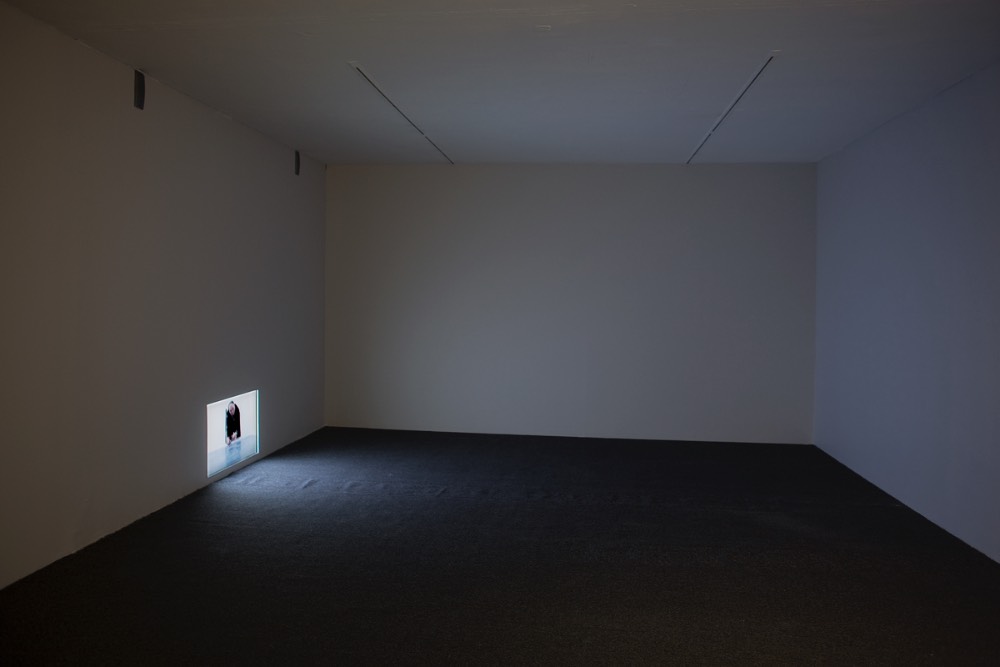
Installation shot of Yoshua Okon's Hausmeister, Single Channel Video 1:24 minutes,
2008.
Yoshua Okón
Yoshua Okón was born in Mexico City, where he currently lives. He received a MFA from UCLA with a Fulbright scholarship. His solo shows exhibitions include: Piovra, Kaufmann Repetto, Milan; Poulpe, Mor Charpentier, Paris; Octopus, Cornerhouse, Manchester and Hammer Museum, Los Angeles and SUBTITLE, Städtische Kunsthalle, Munich. His work has been featured in numerous group exhibitions, including Antes de la Resaca, MUAC, Mexico City; Incongruous, Musèe Cantonal des Beux-Arts, Lausanne; The Mole´s Horizon, Palais des Beaux Arts, Brussels; Amateurs, CCA Wattis, San Francisco; Laughing in a Foreign Language, Hayward Gallery, London; Adaptive Behavior, New Museum, NY; and Mexico City: an exhibition about the exchange rates between bodies and values, PS1, MoMA, NY, and Kunstwerke, Berlin. His work is included in the collections of the Tate Modern, Centre Pompidou, the Hammer Museum, LACMA, the Colección Jumex, and MUAC, among many others.
Statement
My work functions like a series of near-sociological experiments, executed for the camera, blending staged situations, documentation, and improvisation, with the goal of questioning habitual perceptions of reality and truth, selfhood and morality. My single-channel seamless video-installation loop titled Hausemeister is a poetic retelling of a fable, whereby the animal is not humanized, but rather, where the human is animalized. In this video, the Hausemeister is a lizard guarding lair, he is a mouse peeking through hole, he is no longer quite “he.” This shift in the nature of the video’s subject becomes a dislocation of the spectators as well. “We” are being looked at, attacked, or at the very least addressed by this animal, our comfort zone is invaded by this creature who hisses and growls - or perhaps it is we, and our gaze (objectified by the camera) that is invading the Hausemeister’s territory, its home? What is our relationship to other creatures in the world? How have we (dis)placed ourselves as animals in the world, our home? And, ultimately, what is home - where does it begin or end? The question of territory and protection (of homeland security) is allegorized in this humorous, if disturbing, piece.
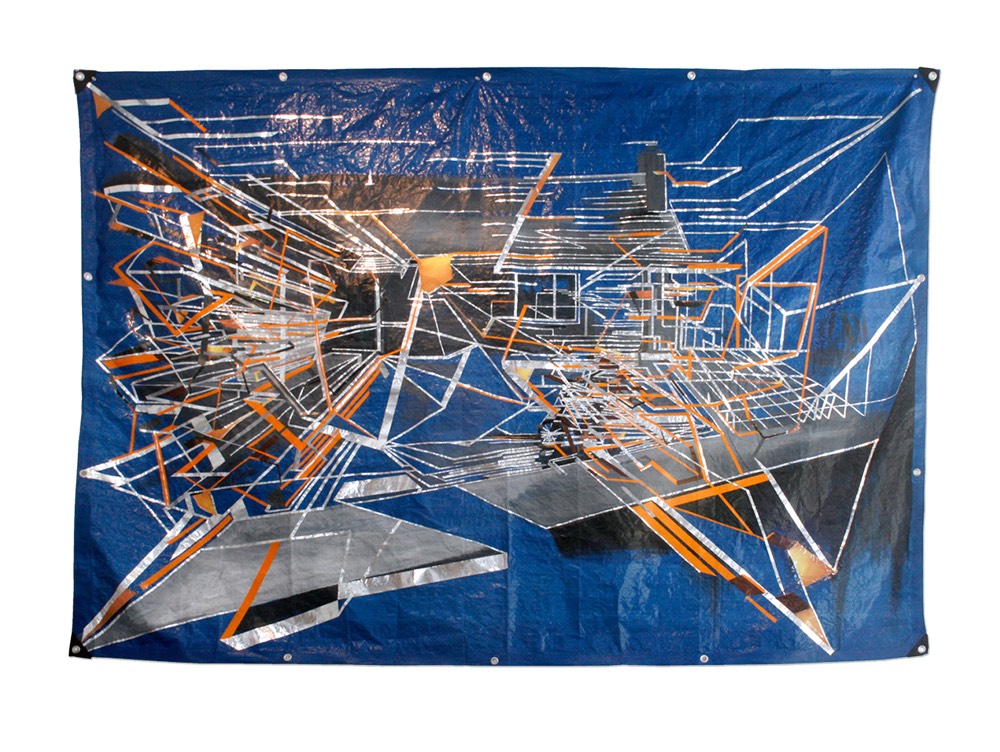
Abel Rodriguez, They Grow Up So Fast, Mixed Media on Construction Tarp, 72" x 96",
2010.
Abel Rodriguez
At every construction zone, a reoccurring image refuses to be overlooked and forgotten. Intersecting vectors from fencing, telephone poles, cranes, and wood debris accumulate to form geometries that resemble ships. At this scene, trajectories of histories and traditions collide. The afterimage of the impact triggers migratory and unstable memories that are in constant flux. Embracing change through my working process as well as through my use of materials, such as tape, I manipulate fragments from found objects that are used as words that can be negotiated, arranged and rearranged into endless visual and communicative statements. The act of deconstructing and reconstructing, ordering and shifting allows me for quick modification and restructuring. The placement of these materials within the architectural container reshuffles their value, function and origin, reclaiming them as building blocks, leaving the finalized sculptural forms to express the potential to shift, morph, or be perceived in new contexts. Through the investigation of exploding and imploding forms, progress and destruction, I address how the perception of these conditions can be shaped by what is visible or hidden.
San Francisco-based artist, Abel Rodriguez, was born in Fairfield, CA. He received a BFA in Drawing & Painting and Graphic Design from California State University Long Beach and a MFA in Painting from Yale School of Art. In 2011, he was selected to participate in the Artist-in-Residence Program at Recology, S.F.
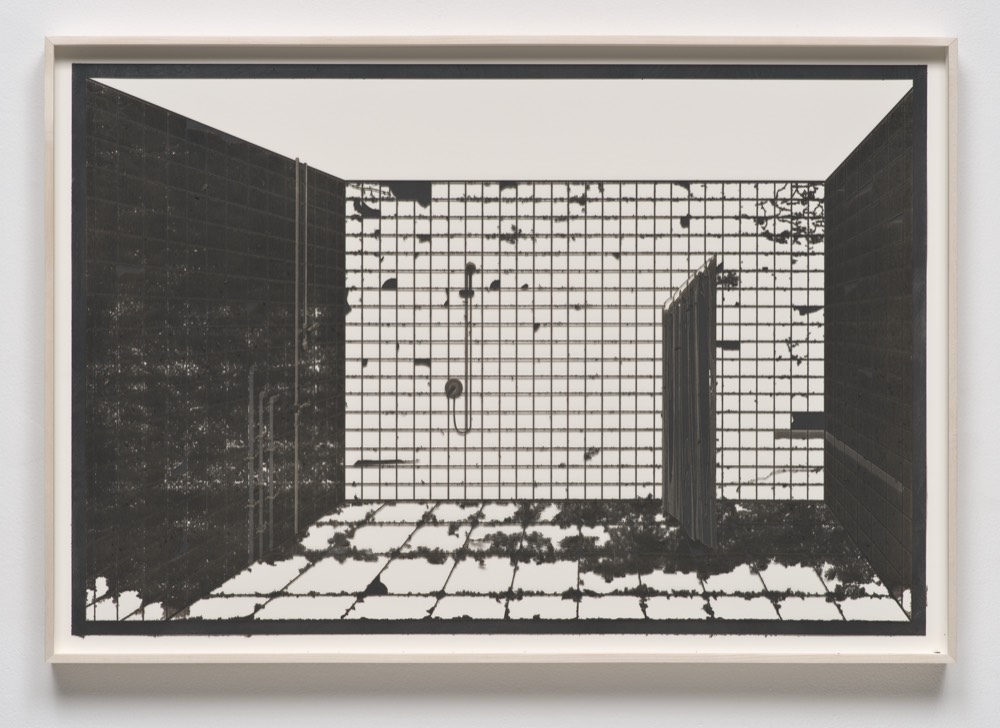
Analia Saban, Erosion (Changing Room) #3, Graphite on Laser Cut Sculpted Paper, 31.5"
x 21.75" x 1.5", 2013.
Analia Saban
I am invested in the use of materials and in dissecting the process of painting and art-making in general. My visual vocabulary is often loaded with art historical references, humor, and evidence of domestic living. My exploration and experimentation in the studio practice often results in work that hovers somewhere between the territories of painting and sculpture. It is this natural duality that I like to investigate - contrasting ideas of negative and positive space, using new techniques/materials to create traditional/referential work, the organic versus the structural, the personal and the universal, etc. The crux of it all is what happens between these territories and conventional definitions. For example, the laser cutter comes into play in my Erosion pieces, in which my drawings are singed onto canvas, leaving only the architecture of the original lines. This body of work focusing on the domestic especially demonstrates my playful, but thorough investigation of the ways in which paint can interact with the canvas and images can be created.
Analia Saban was born in Buenos Aires, Argentina and lives/works in Los Angeles. She holds a BFA in Visual Arts from Loyola University in New Orleans and a MFA in New Genres from UCLA. Saban has had numerous solo exhibitions, nationally and internationally, at Thomas Solomon Gallery, Los Angeles; Tanya Bonakdar, New York; Sprueth Magers Projekte, Munich; Praz-Dellavallade, Paris; Josh Lilley, London, and Galeria 11x7, Buenos Aires. Her work has also been included in Painting in Place at Los Angeles Nomadic Division, On Sincerity at Boston University, Dark Matters: Takes on Conceptual and Minimal Aesthetics at Chapman University, Made in LA at the Hammer Museum, and Suelto at La Central in Bogota, Columbia.
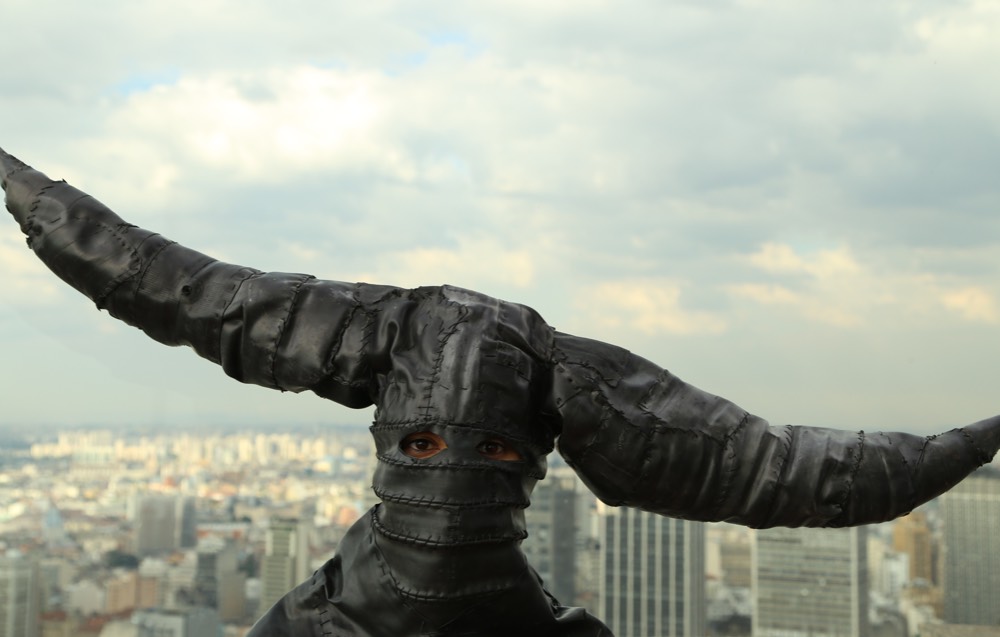

Stay Connected